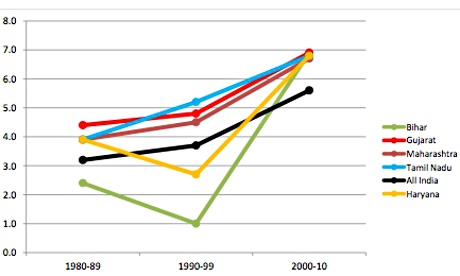 |
| हिन्दी: देश के उप राष्ट्रपति मोहम्मद हामिद अंसारी पटना में पूर्व मुख्यमंत्री सत्येन्द्र नारायण सिन्हा(छोटे साहब) की 94वीं जयंती पर आयोजित व्याख्यानमाला श्रंखला पर पूर्व सांसद किशोरी सिन्हा और मुख्यमंत्री नीतीश कुमार के साथ (Photo credit: Wikipedia) |
But that cutting edge thing does not seem to be happening with the Indian polls. In 2004 the surveys showed the BJP coming back to power. Instead Manmohan Singh became Prime Minister. The surveys were off also in 2009. This time I do think there is a Modi wave, but it is a wave in that it will take the BJP from about 100 seats to 200 seats. When you double your seat count, it can be called a wave. But there are surveys that show Nitish Kumar getting five seats. How do you explain that? His job approval rating in Bihar is close to 70%.
Recently I came across a survey that claimed the BJP was set to get half the seats in the South. That is when I threw the towel. That is not possible. The BJP has no presence in the South. How could it end up with half the seats in the South?
If anything the polls and the surveys have added further mystery to the process. You know no one knows for sure what’s going on. If you give 200 seats to the BJP, and 100 seats to the Congress, that leaves 245 seats to the rest. And the Congress is already giving hints it will stop the BJP at any cost, even if that means supporting the so-called Third Front.
Only Nitish is now calling it the First Front. It is obvious there is a need for a new name. If you are going to build a coalition where the Congress is itself a junior ally in power, you cannot call it the Third Front. Mamata calls it the tired front.
India is such a large democracy, and most Indians are so rural, you have to ask for the methodologies in those surveys. Who are these pollsters calling? And what are they asking? What is their sample size? There was a sting operation a few weeks back that showed all the leading polling agencies were happy tweaking the poll results for the highest bidder. That is like when the search engines before Google put you at the top if you gave them money. There is also an upper caste bias against people like Nitish. And Indian media has been slower to change than Indian political leadership. Indian media is still upper caste dominated. And then there is the corporate bias. The big media houses are owned by the big Indian corporate interests who threw their lot behind Modi a long time ago.
There are two Indians who speak amazing Hindi. One is Amitabh. Another is Nitish. I just love watching both of them speak Hindi on YouTube.
I admitted to my Bihar bias a long time ago. But that does not change the fact that Nitish is the far superior candidate. And that is why I support him. The polls projecting Nitish getting five seats is like some polls projecting the BJP will get half the seats in the South.
I think something new is about to happen in India. India is finally about to prove democracy is a superior form of government to whatever they have in China, but you do have to apply it all the way. And if you do that, you end up with double digit growth rates. Something happened in China around 1980. Something is about to happen in India in 2014. That positive change will be the gift of the Kumbh Mela called the Indian general elections.
Just like there is a global Chinese identity and community, there is a global Indian identity and community. And that identity gets a boost when India does well.
At some point down the line, poll taking in India is going to get a little more scientific, a little more reliable. But that time is not now. So I am not putting too much stock in the polls. And the Indian election procedure lasts a full month. So there will be a lot of waiting before the final results are out. But when they are out, there will be a flurry of activity. I expect Nitish to be camping out in Delhi at that point in time. Coalition building is an art form. Nitish’s ways speak to the diversity of India. And that is what will carry the day. It helps that he is also the top performing Indian politician today. Like Salman Khan said, may the best person get the top job. Nitish is that best person.


















